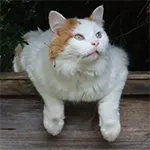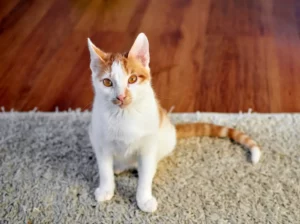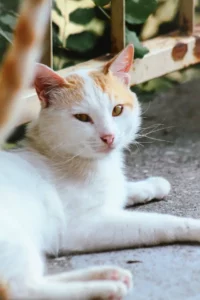
The Turkish Van is a large and muscular cat, although elegant, with a white body and a very characteristic color on both the head and the tail. These cats have a balanced and strong appearance.
Summary
The Turkish Van is a unique and captivating cat breed known for its love of water, distinctive “Van pattern” coat, and playful, affectionate personality. Often referred to as the “swimming cat,” the Turkish Van has a long history and is cherished for its lively and engaging temperament. This guide will provide you with everything you need to know about the Turkish Van, from its origins and physical traits to its care needs and personality, making it a valuable resource for current and prospective Turkish Van owners.
History of the Turkish Van
Ancient Origins
The Turkish Van is an ancient breed that originates from the Lake Van region in modern-day Turkey. The breed has existed for centuries in this area, where it developed its unique characteristics. Turkish Vans were likely naturally occurring cats, with their distinct white bodies and colored markings evolving through natural selection. They were known for their ability to survive in the harsh mountainous environment and their strong swimming ability, which helped them hunt fish in the local lakes.
Introduction to the Western World
The Turkish Van was relatively unknown outside its native region until the 1950s when a pair of British photographers, Laura Lushington and Sonia Halliday, encountered the breed during a trip to Turkey. They were so captivated by the cat’s striking appearance and unique personality that they brought a pair back to the UK. The breed was slowly introduced to the Western world and began gaining recognition. The Turkish Van was officially recognized by the Cat Fanciers’ Association (CFA) in 1985 and has since gained popularity among cat enthusiasts.
Physical Characteristics
Appearance and Size
The Turkish Van is a medium to large-sized cat, with males typically weighing between 10 to 20 pounds and females slightly smaller. They have a strong, muscular build, which contributes to their agility and athleticism. Their bodies are long and well-proportioned, with a slightly rounded chest and powerful legs.
One of the most distinctive features of the Turkish Van is its coat. The breed is known for its “Van pattern,” which consists of a predominantly white body with colored markings on the head and tail. The most common colors are red, cream, black, and blue, often combined with tabby patterns. The coat is semi-long, soft, and silky, without the dense undercoat found in many other long-haired breeds, making it less prone to matting.
Eyes and Expression
Turkish Vans have large, expressive eyes that can be amber, blue, or odd-eyed (one eye of each color). Their eyes are slightly oval-shaped and set at a slight angle, giving them a bright and alert expression. The breed’s ears are moderately large, set high on the head, and slightly rounded at the tips, complementing their overall appearance.
Personality and Temperament
Playful and Energetic
Turkish Vans are known for their playful and energetic nature. They are highly active cats that enjoy climbing, jumping, and exploring their environment. Their natural athleticism makes them excellent jumpers, and they often seek out high perches from which to observe their surroundings. This breed is also known for its intelligence and curiosity, often engaging in interactive play and solving puzzles with ease.
Affectionate and Social
While Turkish Vans are independent and capable of entertaining themselves, they are also affectionate and enjoy spending time with their human families. They form strong bonds with their owners and are known to be loyal and devoted companions. Turkish Vans often follow their owners around the house, seeking attention and interaction. They are also known to be gentle with children and can get along well with other pets, making them an excellent choice for families.
Love of Water
One of the most unique traits of the Turkish Van is its love of water. Unlike most cats, Turkish Vans are known to enjoy swimming and playing in water. This trait likely developed from their origins in the Lake Van region, where they had access to natural bodies of water. Many Turkish Van owners report that their cats enjoy playing in sinks, bathtubs, or even joining them in the shower.
Grooming and Maintenance
Coat Care
Despite their semi-long coat, Turkish Vans are relatively low-maintenance when it comes to grooming. Their coat lacks the dense undercoat that is common in other long-haired breeds, which means it is less prone to matting and tangling. Brushing your Turkish Van once or twice a week is usually sufficient to keep their coat looking its best. Regular brushing also helps to remove loose hairs and reduce shedding.
Bathing and Water Play
Given their love of water, Turkish Vans may actually enjoy the occasional bath. If your cat is comfortable with water, bathing can be a fun and bonding experience. Use a cat-specific shampoo and make sure to rinse thoroughly to avoid any residue on their skin. It’s also important to dry them completely after a bath to prevent them from getting chilled.
Dental and Nail Care
Like all cats, Turkish Vans benefit from regular dental care. Brushing their teeth several times a week with a cat-specific toothpaste can help prevent dental diseases such as tartar buildup and gum disease. Their nails should also be trimmed every few weeks to prevent overgrowth and to keep them from becoming too sharp. Providing scratching posts around your home can help them maintain healthy nails naturally.
Diet and Nutrition
Nutritional Requirements
Turkish Vans are active and muscular cats, so their diet should be rich in high-quality protein to support their energy levels and maintain their muscle mass. Both wet and dry cat food can be part of their diet, but it’s important to choose products that are specifically formulated for their life stage—kitten, adult, or senior. Some Turkish Vans may benefit from a diet that includes a mix of both wet and dry food, which can help ensure they stay hydrated and receive the necessary nutrients.
Portion Control
Due to their active nature, Turkish Vans have a healthy appetite, so it’s important to monitor their food intake to prevent overeating. Providing measured portions based on their age, weight, and activity level is the best way to manage their diet. Avoid free-feeding and instead offer meals at specific times each day. Regularly monitoring your cat’s weight and adjusting their diet as needed can help prevent obesity and related health issues.
Hydration
Ensuring that your Turkish Van stays well-hydrated is crucial. Providing fresh water at all times is essential, and given their affinity for water, some Turkish Vans may enjoy drinking from a running water source like a cat fountain. Wet food can also contribute to their overall hydration, which is important for maintaining healthy kidneys and urinary function.
Health and Lifespan
Common Health Issues
Turkish Vans are generally healthy cats, but like all breeds, they can be prone to certain health issues. Some of the common conditions seen in Turkish Vans include:
- Hypertrophic Cardiomyopathy (HCM): This is a common heart condition in cats, including Turkish Vans, where the heart muscle becomes abnormally thickened. Regular veterinary check-ups and echocardiograms can help detect HCM early.
- Polycystic Kidney Disease (PKD): This genetic condition can affect Turkish Vans, leading to the development of cysts in the kidneys. Genetic testing and regular health screenings can help manage this condition.
- Deafness: Like other cats with a significant amount of white fur, Turkish Vans can be prone to congenital deafness, particularly in individuals with blue or odd-colored eyes. It’s important to have your cat’s hearing checked by a veterinarian, especially if you notice any signs of hearing loss.
Lifespan
With proper care, Turkish Vans typically live between 12 to 17 years, although some can live even longer. Ensuring they have a balanced diet, regular exercise, and routine veterinary care can help them lead a long, healthy life.
Tips for Living with a Turkish Van
Provide Plenty of Stimulation
Turkish Vans are active and intelligent cats that require plenty of mental and physical stimulation to stay happy. Providing a variety of toys, interactive play sessions, and puzzle feeders can help keep them engaged. They also enjoy climbing and exploring, so cat trees, shelves, and window perches can provide the enrichment they need.
Social Interaction
Turkish Vans are social cats that thrive on interaction with their human families. Make sure to spend quality time with your Turkish Van, whether it’s through play, grooming, or simply keeping them company. They don’t like being left alone for long periods, so if your household is often empty, consider getting another pet to keep them company.
Regular Veterinary Care
Due to their susceptibility to certain health issues, regular veterinary check-ups are essential for Turkish Vans. Annual or bi-annual visits will help monitor their health and detect any issues early, ensuring they remain healthy and happy.
FAQs about Turkish Van Cats
Are Turkish Vans good with children?
Yes, Turkish Vans are known for their playful and patient nature, making them excellent companions for families with children. They enjoy interacting with kids and are generally gentle and tolerant, making them well-suited to an active household.
How much grooming do Turkish Vans require?
Turkish Vans have a semi-long coat that requires regular brushing, typically once or twice a week, to keep it free of tangles and matting. Despite their long hair, they are relatively low-maintenance compared to other long-haired breeds.
Do Turkish Vans get along with other pets?
Yes, Turkish Vans are social cats that generally get along well with other pets, including dogs and other cats. Their outgoing and adaptable nature makes them a good fit for multi-pet households.
What health issues are common in Turkish Vans?
Turkish Vans are generally healthy but can be prone to certain conditions such as Hypertrophic Cardiomyopathy (HCM), Polycystic Kidney Disease (PKD), and congenital deafness, particularly in individuals with white fur and blue or odd-colored eyes. Regular veterinary check-ups and genetic testing can help in early detection and management of these conditions.
How long do Turkish Vans live?
With proper care, Turkish Vans typically live between 12 to 17 years, although some may live longer. Regular exercise, a balanced diet, and routine health checks are key to ensuring a long, healthy life for your Turkish Van.
Latest on CatOlympus
Effects Of Music On Cats: Do Cats Enjoy Music?
For many cat owners, music is a regular part of daily life. We play it while cooking, cleaning, relaxing, or...
Myths And Truths About Feeding Your Cat
Feeding your cat is more than just picking up the nearest bag of kibble. It’s about providing balanced nutrition to...
How To Ensure Your Cat Drinks Enough Water
Water is essential for life, and just like humans, cats need adequate hydration to maintain their health and well-being. However,...
How to Spot and Prevent Parasites In Cats
Parasites are an unfortunate but common issue that many cat owners will face at some point. These unwelcome visitors can...











